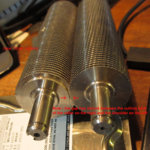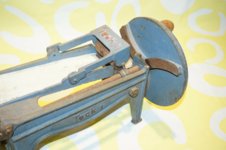The Orig Ralph
Member
i used to post here under "larryccf" but can't seem to get my password to work, so i registered under this name. I only came back as i originally posted about the G120 tobacco shredder i had ordered from the polish vendor tobaccoandmachines.com. Cost at the time was $220 shipped, with Polish VAT removed. VAT and shipping were nearly equal. I'd chosen it as it's rollers were the largest in diameter (32mm) in a $200 price range, and i'd already had a lower priced unit bend a roller the first time a small pc of stem had gone thru the machine. This G120 has a few miles on it, and while i was originally impressed with how it shredded, i'm disappointed with it's lack of durability, at this point after approx 50 lbs of leaf thru it. $220 divided by 50 lbs is over $4/lb shredding cost.
With less than 50 lbs of leaf thru it, mostly Va Lemon & 1st priming from Don, the original set of .8mm rollers are shot. But what i noticed over time was that i was getting more and more dust and less actual shag or strands whenever i'd shred. I'd clean the machine after every use with a brush & alcohol, removed the combs and checked them, re-adjusted them and would still get the same dust. On the last run, about 95% of the product could easily be sold for snuff, nearly as fine as talcum powder.
I discovered why when i took it all the way apart, including pulling the gears and the actual rollers. I was pulling it apart as the machine had gotten extremely stiff to turn, judging from the hand crank handle and i figured the bearings were stiff. Nope,, bearing were fine - The rollers were soft metal, not heat treated, and that's the core of the problem. When i went to tap the shaft at one end of one of the rollers out of the gear, using a small 4 oz hammer, instead of it moving thru the gear, it malleted out (ie the shaft grew in diameter where i was tapping, the same as lead would. But what else i found, once i had the rollers totally out, was the cutting lands from one roller would not totally engage into the grooves on the opposing rollers. While they'd worn down some, not much but slight indentations that acted as shallow teeth were worn smooth, the only thing i can figure is the lands had malleted some from shredding, ie fattened some so they wouldn't fit between the lands on the opposing rollers. The edges of the cutting lands have dulled, the same way a knife will dull if the blade isn't hardened. But it appears what was happening, to give me all the dust, was that the cutting lands were simply crushing the tobacco against the sides of the opposing lands, and vice versa.
I've got a little bit of knowledge re hardening metals and talked to Paul at Tobacco and machines about this. His excuse was that it would be too expensive to use hardened steel. And he may be right, but it's more expensive to a user to get 50 lbs of usage out of a $220 machine. What he meant about "too expensive", a lot of alloys, if you try to heat treat them after machining, they will warp, so the solution is to buy the alloy rod pre-hardened or pre-heat treated. BUt the problem there is, in a hardened state, the metal is harder to work, so the machinist has to turn the spindle at a slower cutting speed, which means slower cycle time to produce - the average 4 axis lathe to run producing these rollers, industry standard, will run $45-$50 per hour with mechanic. If you can get 10 rollers turned or produced in an hour with unhardened metal, vs 6 per hour with hardened metal, well you can see the math, cost wise to produce. 2nd consideration in cutting narrow .8mm or even 1mm grooves, is that the cutting bits are going to be narrow and fragile - and they would suffer high breakage rate cutting hardened metal, which means scrapped rollers, half finished. 3rd issue, is the shallow teeth on the rollers are produced by using a roller die (hardened roller die) - and it can't produce those "teeth" on hardened metal
By their very nature, all these small $100 to $200 roller shredders are short life span affairs. I've ordered a replacement set of 1mm rollers from Paul at Tobacco and Machines ($140 shipped with 1mm combs) and don't really expect any different life from them, but i'm out of shredded tobacco (or nearly so) and need to get shredding.
I looked into designing and producing a better machine, but the cost in a production run of 500 units, would be what i paid for this one and to be frank, i'm retired - while i'm a little bored, i'm just not interested in dealing with fabrication shops, sourcing materials etc. I do realize why Powermatic went with their stamped cutters - it's actually the smarter way to go. If they sell replacement cutting plates, i'd be ordering one of them - but i wasn't ready to spend $300 on a new unit right now.
I also noticed higher priced shredding roller sets available on ebay poland, and hope / assume they used hardened rollers, considering their pricing.
I've ordered one of those Teck 1 antique shredders, after seeing a youtube video of one producing 1mm cut strands. At least the blades can be sharpened and/or replaced fairly economically and look fairly easy to adapt a motor to it.
I've attached some files of the old .8mm rollers, and the new 1mm rollers - notice the difference in depth engagement of the cutting lands on the new rollers vs the old .8mm rollers (highlighted with red arrow).
With less than 50 lbs of leaf thru it, mostly Va Lemon & 1st priming from Don, the original set of .8mm rollers are shot. But what i noticed over time was that i was getting more and more dust and less actual shag or strands whenever i'd shred. I'd clean the machine after every use with a brush & alcohol, removed the combs and checked them, re-adjusted them and would still get the same dust. On the last run, about 95% of the product could easily be sold for snuff, nearly as fine as talcum powder.
I discovered why when i took it all the way apart, including pulling the gears and the actual rollers. I was pulling it apart as the machine had gotten extremely stiff to turn, judging from the hand crank handle and i figured the bearings were stiff. Nope,, bearing were fine - The rollers were soft metal, not heat treated, and that's the core of the problem. When i went to tap the shaft at one end of one of the rollers out of the gear, using a small 4 oz hammer, instead of it moving thru the gear, it malleted out (ie the shaft grew in diameter where i was tapping, the same as lead would. But what else i found, once i had the rollers totally out, was the cutting lands from one roller would not totally engage into the grooves on the opposing rollers. While they'd worn down some, not much but slight indentations that acted as shallow teeth were worn smooth, the only thing i can figure is the lands had malleted some from shredding, ie fattened some so they wouldn't fit between the lands on the opposing rollers. The edges of the cutting lands have dulled, the same way a knife will dull if the blade isn't hardened. But it appears what was happening, to give me all the dust, was that the cutting lands were simply crushing the tobacco against the sides of the opposing lands, and vice versa.
I've got a little bit of knowledge re hardening metals and talked to Paul at Tobacco and machines about this. His excuse was that it would be too expensive to use hardened steel. And he may be right, but it's more expensive to a user to get 50 lbs of usage out of a $220 machine. What he meant about "too expensive", a lot of alloys, if you try to heat treat them after machining, they will warp, so the solution is to buy the alloy rod pre-hardened or pre-heat treated. BUt the problem there is, in a hardened state, the metal is harder to work, so the machinist has to turn the spindle at a slower cutting speed, which means slower cycle time to produce - the average 4 axis lathe to run producing these rollers, industry standard, will run $45-$50 per hour with mechanic. If you can get 10 rollers turned or produced in an hour with unhardened metal, vs 6 per hour with hardened metal, well you can see the math, cost wise to produce. 2nd consideration in cutting narrow .8mm or even 1mm grooves, is that the cutting bits are going to be narrow and fragile - and they would suffer high breakage rate cutting hardened metal, which means scrapped rollers, half finished. 3rd issue, is the shallow teeth on the rollers are produced by using a roller die (hardened roller die) - and it can't produce those "teeth" on hardened metal
By their very nature, all these small $100 to $200 roller shredders are short life span affairs. I've ordered a replacement set of 1mm rollers from Paul at Tobacco and Machines ($140 shipped with 1mm combs) and don't really expect any different life from them, but i'm out of shredded tobacco (or nearly so) and need to get shredding.
I looked into designing and producing a better machine, but the cost in a production run of 500 units, would be what i paid for this one and to be frank, i'm retired - while i'm a little bored, i'm just not interested in dealing with fabrication shops, sourcing materials etc. I do realize why Powermatic went with their stamped cutters - it's actually the smarter way to go. If they sell replacement cutting plates, i'd be ordering one of them - but i wasn't ready to spend $300 on a new unit right now.
I also noticed higher priced shredding roller sets available on ebay poland, and hope / assume they used hardened rollers, considering their pricing.
I've ordered one of those Teck 1 antique shredders, after seeing a youtube video of one producing 1mm cut strands. At least the blades can be sharpened and/or replaced fairly economically and look fairly easy to adapt a motor to it.
I've attached some files of the old .8mm rollers, and the new 1mm rollers - notice the difference in depth engagement of the cutting lands on the new rollers vs the old .8mm rollers (highlighted with red arrow).












